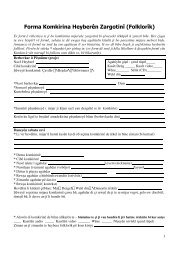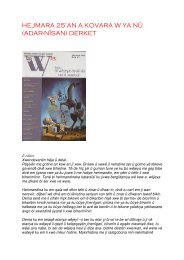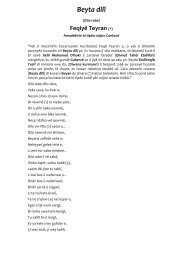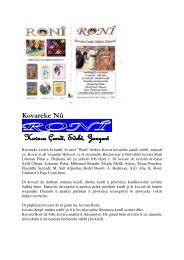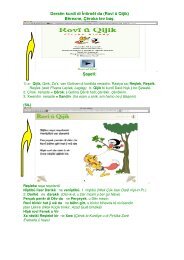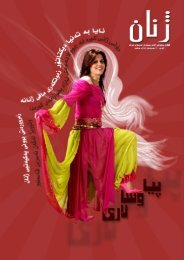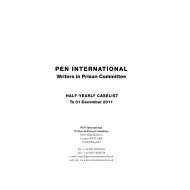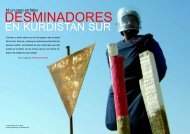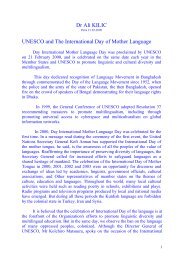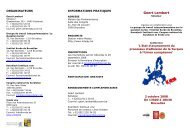The Kurds in Khorasan, North-east of Iran - Pen-Kurd
The Kurds in Khorasan, North-east of Iran - Pen-Kurd
The Kurds in Khorasan, North-east of Iran - Pen-Kurd
Create successful ePaper yourself
Turn your PDF publications into a flip-book with our unique Google optimized e-Paper software.
It is needless to say that the lack <strong>of</strong> state <strong>in</strong>vestment has left the area <strong>in</strong> destitution,undeveloped with no prosperity; about 23% <strong>of</strong> <strong><strong>Kurd</strong>s</strong> <strong>in</strong> <strong>Khorasan</strong> are completelyilliterate especially nomadic immigrants.<strong>Khorasan</strong>i <strong><strong>Kurd</strong>s</strong> are not allowed to be educated <strong>in</strong> their own mother language, andthe regional rul<strong>in</strong>g <strong>of</strong>ficialdom is not from khorasani <strong><strong>Kurd</strong>s</strong>. <strong>The</strong>y are not allowed tohave any organised <strong>Kurd</strong>ish political, cultural, educational and civil centres or forumsto improve and modernise their culture, language and social affairs which is theirlogical basic civil rights, <strong>in</strong> <strong>Iran</strong>. <strong>Khorasan</strong>i <strong><strong>Kurd</strong>s</strong> does not have any radio or TVstation <strong>in</strong> their language. <strong>Kurd</strong>ish leaders, <strong>in</strong>tellectuals and writers are prosecuted,<strong>in</strong>sulted, oppressed and jailed.<strong>Kurd</strong>ish tribes <strong>in</strong> <strong>Khorasan</strong> are mostly settled <strong>in</strong> regional cities and villages, althoughthere still are some pastoralist migrat<strong>in</strong>g nomads. Those who are settled <strong>in</strong> the villageswork <strong>in</strong> agricultural (sugar beets, cotton, cereals, vegetables, by-product such as hayetc.), garden<strong>in</strong>g (fruits, grapes, nut trees etc.) and livestock economy. Those who live<strong>in</strong> the cities <strong>in</strong>volved <strong>in</strong> public and private sectors, and <strong>in</strong> market trad<strong>in</strong>g society. <strong>The</strong>average rate <strong>of</strong> state employment <strong>in</strong> <strong>Khorasan</strong>i <strong>Kurd</strong>ish region estimates about 15%respectively.Pastoralist herd<strong>in</strong>g especially <strong>in</strong> mounta<strong>in</strong>s and the steep slops is a way <strong>of</strong> traditionaleconomy yet. <strong>The</strong> most important livestock <strong>of</strong> <strong>Kurd</strong>ish tribes are sheep and to a lesserextent goats and cattle. Animal products <strong>in</strong>clude; meat, milk, wool, leather and dairyproducts such as; cheeses, yogurt, curds, buttermilk and butter. <strong>Kurd</strong>ish handmaderugs, kelims, carpets and other textiles are still produced <strong>in</strong> relatively large quantities.<strong>The</strong>re is not that traditional tribal power structure (see later) anymore by hav<strong>in</strong>g amodern state govern<strong>in</strong>g and economy system <strong>in</strong> <strong>Iran</strong>. <strong>The</strong> most majority <strong>of</strong> <strong>Khorasan</strong>i<strong>Kurd</strong>ish <strong>in</strong>tellectuals want to preserve their culture, language and traditions with<strong>in</strong> aplural society by a modern rul<strong>in</strong>g style based on UN human rights framework <strong>in</strong> thestate <strong>of</strong> <strong>Iran</strong>.Nowadays, as <strong>in</strong>dustrialised age with the high <strong>in</strong>formation technology, transportationsand communications, there is not that tribes’ chiefta<strong>in</strong>s left <strong>in</strong> <strong>Kurd</strong>ish region <strong>of</strong><strong>Khorasan</strong> and by this; the collection <strong>of</strong> revenue and manpower <strong>in</strong> aim <strong>of</strong> govern<strong>in</strong>gthe tribes, rema<strong>in</strong>s too weak. Individualism and the values <strong>of</strong> democracy andpluralism are gett<strong>in</strong>g stronger amongst young generations day by day, although thereis no that state <strong>in</strong>vestment <strong>in</strong> the region. Infrastructurally, khorasani <strong>Kurd</strong>ish region isthe l<strong>east</strong> developed, the overall level <strong>of</strong> modern improvements rema<strong>in</strong>s below thenational averages, <strong>in</strong> comparison to other prov<strong>in</strong>ces such as Tehran and Esfahan.<strong>Khorasan</strong>i <strong>Kurd</strong>ish region has two sites <strong>of</strong> oil reserves as natural resources; one is <strong>in</strong>Quchan and the other one <strong>in</strong> Raz. <strong>The</strong>re is a Gas field <strong>in</strong> Khangiran, Sarakhs. <strong>The</strong>seoil reserves are not <strong>in</strong> use yet as there is no oil ref<strong>in</strong>ement there, although it might beuseful for the local petrochemical factory <strong>in</strong> Bojnurd.Women are allowed some freedom <strong>in</strong> compare to the other people for example Baluchor Arabs. <strong>Kurd</strong>ish nomadic women are semi-unveiled, except <strong>in</strong> cities and large towns8



